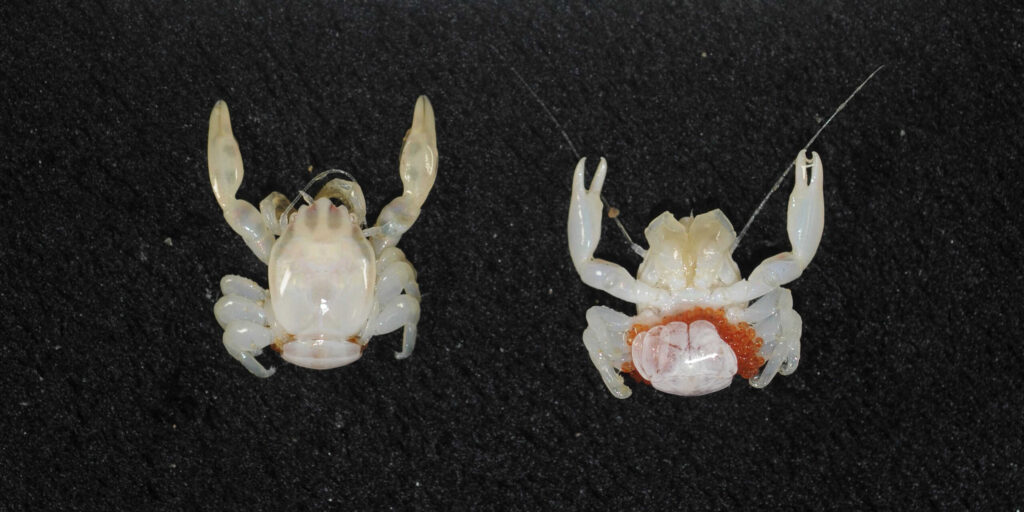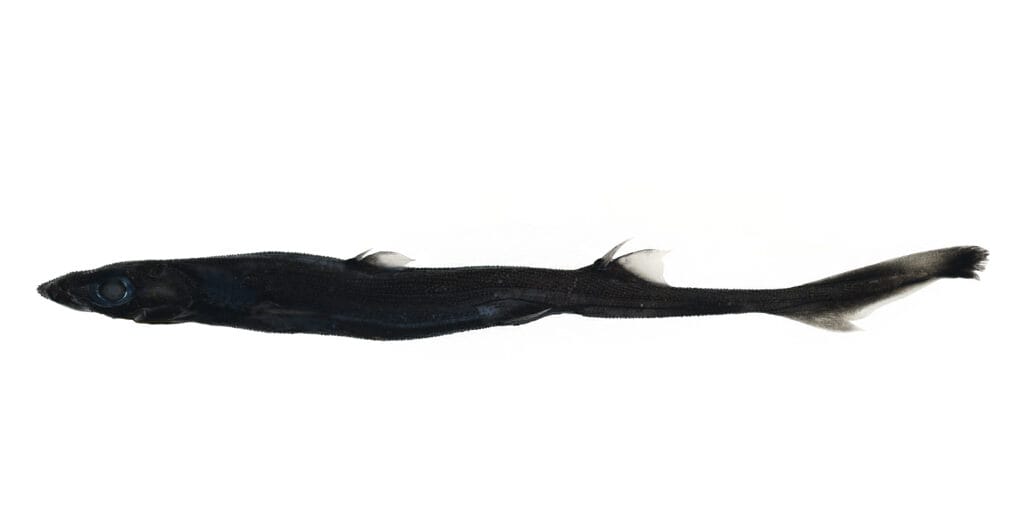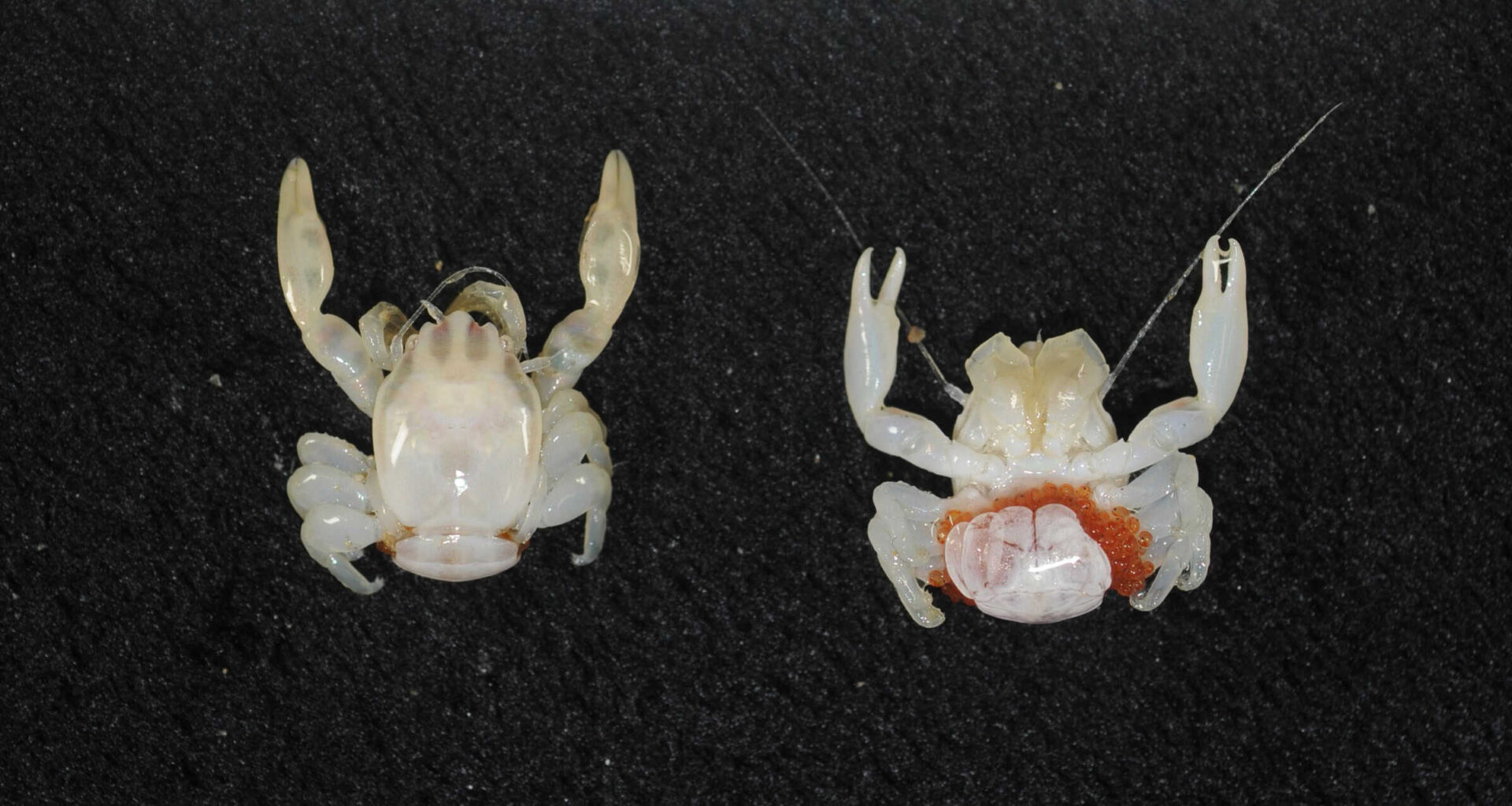 What has four claws and is excited to be a species that’s new to science? This little porcelain crab, of course! Image: CSIRO-Cindy Bessey.
What has four claws and is excited to be a species that’s new to science? This little porcelain crab, of course! Image: CSIRO-Cindy Bessey.
Two thousand feet below the surface of Western Australia’s coast, a light flickers where no sunlight reaches. It’s not from a submersible or diver’s lamp — it comes from a shark. Nearby, two translucent crabs cling to the fronds of a soft coral, filtering plankton from the current.
These small, fragile animals — a glowing lanternshark and two new species of porcelain crab — are among the latest discoveries from a 2022 CSIRO expedition to the Gascoyne Marine Park. The month-long voyage, run by Australia’s national science agency, uncovered a hidden world of strange and delicate creatures in one of the planet’s least explored marine regions.
“I think all up, including things like crabs and the mollusks, there’s close to 600 new species potentially from that one survey,” Dr. Will White, ichthyologist with CSIRO’s Australian National Fish Collection, told ABC News.
The discoveries, just recently described in scientific journals including Ecology and Evolution and the Journal of Fish Biology, reveal how much of Earth’s biodiversity still lies beyond our reach.
The Little Lantern That Lives in the Dark
 The West Australian Lanternshark was described with the help of six specimens collected off the WA coast during a voyage on RV Investigator in 2022. Image: CSIRO Australian National Fish Collection.
The West Australian Lanternshark was described with the help of six specimens collected off the WA coast during a voyage on RV Investigator in 2022. Image: CSIRO Australian National Fish Collection.
At a depth of about 610 meters, White and his team found the West Australian Lanternshark (Etmopterus westraliensis), a slender fish new to science whose body glows blue and green. Its light comes from tiny organs called photophores scattered along its belly and sides.
“Lanternsharks are an amazing group of sharks, and this new species was found at depths to 610 meters during biodiversity surveys for Parks Australia in the Gascoyne Marine Park,” said Dr. White in a press release.
Growing up to 40 centimeters long, the lanternshark is one of the smallest sharks in the world. It uses its glow to blend with faint light above or perhaps signal to others in the dark.
“We often think of sharks as these big white sharks,” White explained. “But lantern sharks are only about 20–30 cm long sometimes. And they’ve got these little light organs all down their bodies so in the deep, there’s little flashing blue and green lights they emit.”
This glowing predator joins a growing list of deep-sea discoveries from the expedition — including the painted hornshark, the ridged-egg catshark, and a bright red “flapjack” octopus. But the team also found something far smaller and far stranger clinging to coral near the seabed.
The Crabs That Rewrote the Book
 The porcelain crab (Porcellanella brevidentata), found 120 meters below the surface, is an opalescent crustacean. Credit: CSIRO.
The porcelain crab (Porcellanella brevidentata), found 120 meters below the surface, is an opalescent crustacean. Credit: CSIRO.
The new study published in Ecology and Evolution describes two species of tiny porcelain crabs: Porcellanella brevidentata and Porcellanella longiloba.
Each is barely 1.5 centimeters long, about the size of a paperclip. They live in symbiosis with sea pens (soft corals shaped like quills) at depths of around 120 meters.
“Porcelain crabs are known as filter feeders, feeding on plankton by using modified mouthparts with long hairs to sweep the water for small pieces of food such as plankton, rather than the typical crab method of grabbing and pinching food with their claws,” co-author Dr. Andrew Hosie of the Western Australian Museum, told the BBC.
Their discovery ended a long-running taxonomic mystery. For years, scientists debated whether Australia’s porcelain crabs were one species or several. By combining DNA analysis with close examination of physical traits, from spine length to claw shape, researchers confirmed that two entirely new species had been hiding in plain sight.
The researchers also reinstated a forgotten species, Porcellanella picta. It was first described in 1858 and later confused with its Australian relatives. Using advanced genetic sequencing, the study mapped four genetic lineages in the Porcellanella family: one Asian and three Australian.
The Ocean Beneath the Map
 Dr Will White (far left) and John Pogonoski (far right) from the CSIRO Australian National Fish Collection examine fish specimens with a colleague onboard RV Investigator in 2022. Image: CSIRO-Frederique Olivier.
Dr Will White (far left) and John Pogonoski (far right) from the CSIRO Australian National Fish Collection examine fish specimens with a colleague onboard RV Investigator in 2022. Image: CSIRO-Frederique Olivier.
The Gascoyne Marine Park discoveries remind us how little of the planet’s biodiversity has been seen, let alone named. Scientists estimate there could be up to 8.7 million living species, with just a fraction described, and millions more likely lurking in the deep. One study from last week estimates 87% of all extant species on Earth are unknown to science.
Future CSIRO expeditions are already planned for the Coral Sea Marine Park, covering nearly a million square kilometers. “The benthic zone is the ecological region at the interface of the ocean and the Earth’s crust,” said White. “It means we’ll be exploring the deepest habitats where some of the most interesting and least known species live… fish without eyes, swimming sea cucumbers, deep-sea corals, and many species perhaps never before seen by human eyes.”
 More than 50 crew worked shifts to cover 24-hour operations on board the vessel. Credit: Frederique Olivier, CSIRO.
More than 50 crew worked shifts to cover 24-hour operations on board the vessel. Credit: Frederique Olivier, CSIRO.
These efforts, said CSIRO chief scientist John Keesing, have important practical implications: “It helps us monitor for the effects of climate change and discover new species that are not known, some of which might go on to be important, either economically through fishing or even for developing medicines.”

